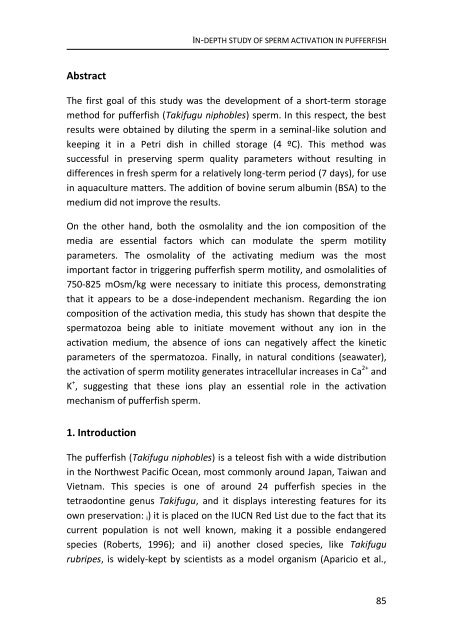chapter 3 - RiuNet
chapter 3 - RiuNet
chapter 3 - RiuNet
Create successful ePaper yourself
Turn your PDF publications into a flip-book with our unique Google optimized e-Paper software.
IN-DEPTH STUDY OF SPERM ACTIVATION IN PUFFERFISH<br />
Abstract<br />
The first goal of this study was the development of a short-term storage<br />
method for pufferfish (Takifugu niphobles) sperm. In this respect, the best<br />
results were obtained by diluting the sperm in a seminal-like solution and<br />
keeping it in a Petri dish in chilled storage (4 ºC). This method was<br />
successful in preserving sperm quality parameters without resulting in<br />
differences in fresh sperm for a relatively long-term period (7 days), for use<br />
in aquaculture matters. The addition of bovine serum albumin (BSA) to the<br />
medium did not improve the results.<br />
On the other hand, both the osmolality and the ion composition of the<br />
media are essential factors which can modulate the sperm motility<br />
parameters. The osmolality of the activating medium was the most<br />
important factor in triggering pufferfish sperm motility, and osmolalities of<br />
750-825 mOsm/kg were necessary to initiate this process, demonstrating<br />
that it appears to be a dose-independent mechanism. Regarding the ion<br />
composition of the activation media, this study has shown that despite the<br />
spermatozoa being able to initiate movement without any ion in the<br />
activation medium, the absence of ions can negatively affect the kinetic<br />
parameters of the spermatozoa. Finally, in natural conditions (seawater),<br />
the activation of sperm motility generates intracellular increases in Ca 2+ and<br />
K + , suggesting that these ions play an essential role in the activation<br />
mechanism of pufferfish sperm.<br />
1. Introduction<br />
The pufferfish (Takifugu niphobles) is a teleost fish with a wide distribution<br />
in the Northwest Pacific Ocean, most commonly around Japan, Taiwan and<br />
Vietnam. This species is one of around 24 pufferfish species in the<br />
tetraodontine genus Takifugu, and it displays interesting features for its<br />
own preservation: i ) it is placed on the IUCN Red List due to the fact that its<br />
current population is not well known, making it a possible endangered<br />
species (Roberts, 1996); and ii) another closed species, like Takifugu<br />
rubripes, is widely-kept by scientists as a model organism (Aparicio et al.,<br />
85
















